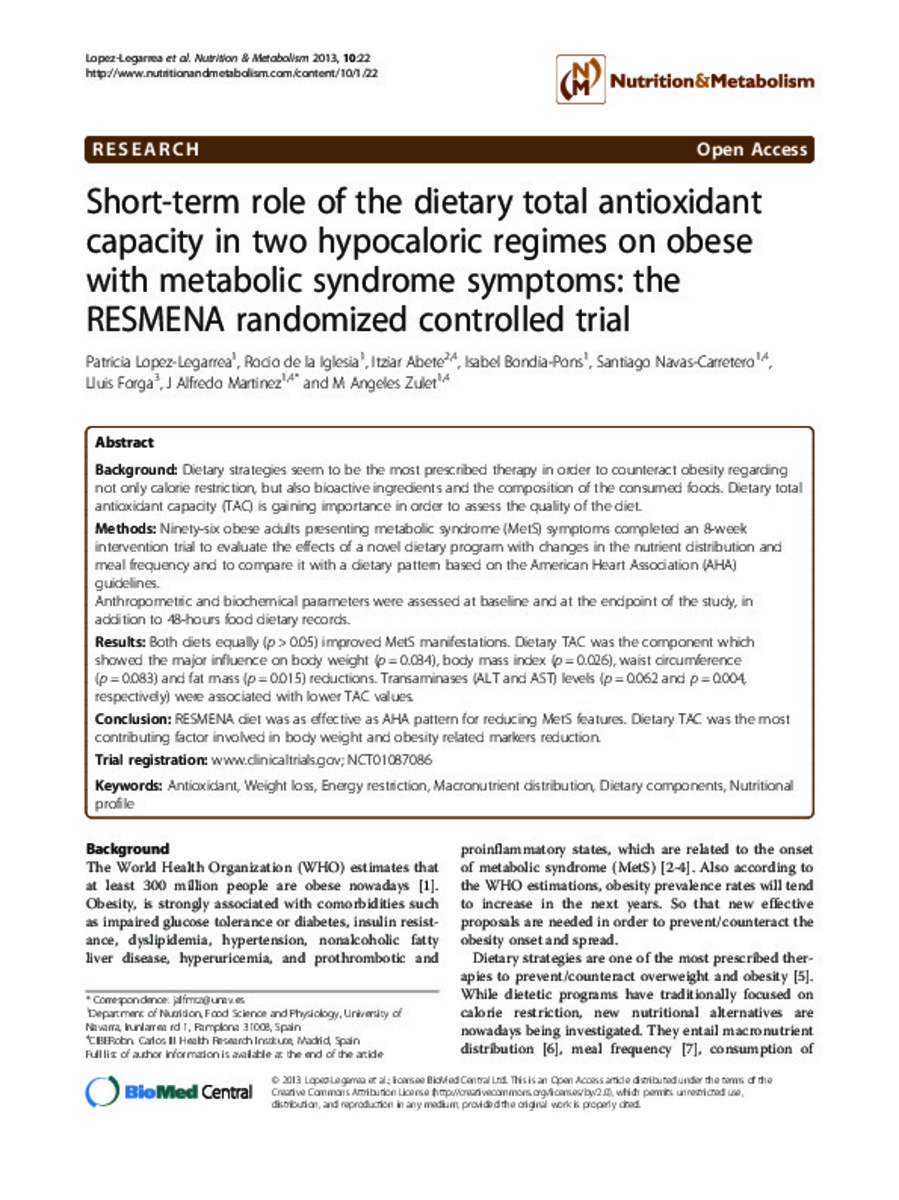Full metadata record
| DC Field | Value | Language |
|---|---|---|
| dc.creator | Lopez-Legarrea, P. (Patricia) | - |
| dc.creator | Iglesia, R. (Rocío) de la | - |
| dc.creator | Abete, I. (Itziar) | - |
| dc.creator | Bondia-Pons, I. (I.) | - |
| dc.creator | Navas-Carretero, S. (Santiago) | - |
| dc.creator | Forga, L. (Luis) | - |
| dc.creator | Martinez, J.A. (José Alfredo) | - |
| dc.creator | Zulet, M.A. (María Ángeles) | - |
| dc.date.accessioned | 2013-09-20T11:35:02Z | - |
| dc.date.available | 2013-09-20T11:35:02Z | - |
| dc.date.issued | 2013 | - |
| dc.identifier.citation | Lopez-Legarrea P, de la Iglesia R, Abete I, Bondia-Pons I, Navas-Carretero S, Forga L, et al. Short-term role of the dietary total antioxidant capacity in two hypocaloric regimes on obese with metabolic syndrome symptoms: the RESMENA randomized controlled trial. Nutr Metab 2013 FEB 13;10:22 | es_ES |
| dc.identifier.issn | 1743-7075 | - |
| dc.identifier.uri | https://hdl.handle.net/10171/29747 | - |
| dc.description.abstract | Background: Dietary strategies seem to be the most prescribed therapy in order to counteract obesity regarding not only calorie restriction, but also bioactive ingredients and the composition of the consumed foods. Dietary total antioxidant capacity (TAC) is gaining importance in order to assess the quality of the diet. Methods: Ninety-six obese adults presenting metabolic syndrome (MetS) symptoms completed an 8-week intervention trial to evaluate the effects of a novel dietary program with changes in the nutrient distribution and meal frequency and to compare it with a dietary pattern based on the American Heart Association (AHA) guidelines. Anthropometric and biochemical parameters were assessed at baseline and at the endpoint of the study, in addition to 48-hours food dietary records. Results: Both diets equally (p > 0.05) improved MetS manifestations. Dietary TAC was the component which showed the major influence on body weight (p = 0.034), body mass index (p = 0.026), waist circumference (p = 0.083) and fat mass (p = 0.015) reductions. Transaminases (ALT and AST) levels (p = 0.062 and p = 0.004, respectively) were associated with lower TAC values. Conclusion: RESMENA diet was as effective as AHA pattern for reducing MetS features. Dietary TAC was the most contributing factor involved in body weight and obesity related markers reduction. | es_ES |
| dc.language.iso | eng | es_ES |
| dc.publisher | BioMed Central | es_ES |
| dc.rights | info:eu-repo/semantics/openAccess | es_ES |
| dc.subject | Antioxidant | es_ES |
| dc.subject | Weight loss | es_ES |
| dc.subject | Energy restriction | es_ES |
| dc.subject | Macronutrient distribution | es_ES |
| dc.subject | Dietary components | es_ES |
| dc.subject | Nutritional profile | es_ES |
| dc.title | Short-term role of the dietary total antioxidant capacity in two hypocaloric regimes on obese with metabolic syndrome symptoms: the RESMENA randomized controlled trial | es_ES |
| dc.type | info:eu-repo/semantics/article | es_ES |
| dc.type.driver | info:eu-repo/semantics/article | es_ES |
| dc.identifier.doi | http://dx.doi.org/10.1186/1743-7075-10-22 | es_ES |
Files in This Item:
Statistics and impact
Items in Dadun are protected by copyright, with all rights reserved, unless otherwise indicated.






